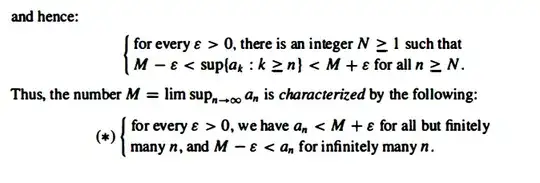For all $\epsilon > 0$, we have $a_n < M + \epsilon$ for all but finitely many $n$ and $M - \epsilon < a_n$ for infinitely many $n$. where $M = \limsup a_n$ (Carother page 12)
I am mainly having trouble with the second inequality $a_n > M - \epsilon.$ But I'll show you the first one anyways.
Let $(a_n)$ be a bounded sequence and $a_N^+ = \sup \{a_n: n \geq N\}$
By definition of $\lim$ we have
For all $\epsilon >0$, there is a integer $b$ such that $ \forall N \geq b \implies -\epsilon + M < a_N^+ < M + \epsilon.$
For the first part $a_N^+ < M + \epsilon$ is true for all $N \geq b$. Therefore by definition of sup, we have $a_n < M + \epsilon$ for all $n \geq b $. But it may not be true for $\{0,\dots, b\}$ of $b$ elements.
Now the thing that is throwing me off about the second one is that it mentions only infinitely many $n$.
For the inequality $M - \epsilon < a_N^+$ for $N \geq b$, by definition of supremum, there must be a point $c \geq b$ such that $n \geq c \implies M - \epsilon < a_n$.
But I do't see why we are withdrawing the "but finitely many" part for the other inequality.
